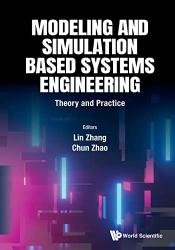 Название: Modeling and Simulation Based Systems Engineering: Theory and Practice
Название: Modeling and Simulation Based Systems Engineering: Theory and PracticeАвтор: Lin Zhang, Chun Zhao
Издательство: World Scientific Publishing
Год: 2023
Страниц: 270
Язык: английский
Формат: pdf (true)
Размер: 28.6 MB
Modeling and simulation (M&S) based systems engineering (MSBSE) is the extension of MBSE, which enhances the value of MBSE and the ability of digitally evaluating and optimizing the whole system through comprehensive applications of M&S technologies. This book puts together the recent research in MSBSE, and hopefully this will provide the researchers and engineers with reference cases in M&S technologies to support the R&D of complex products and systems.
Model-based Systems Engineering (MBSE) is considered the most important means to achieve innovative design and development of complex products or systems. It emphasizes the role and value of the model and fully embodies the model thinking. MBSE promotes the document-based communication mode in traditional systems engineering to the model-based communication mode, which significantly improves the efficiency of large-scale collaboration between participants and minimizes the ambiguity, misunderstanding and even errors that may occur in communications. However, for the development of a complex system, getting through the obstacles in personnel communications is not the whole of modeling. How to make full use of formalized models to quickly verify and optimize the system performances, so as to realize the digitalization and intellectualization of the whole process of system R&D, which really brings the maximum value of the model into play.
In recently years, the modeling and simulation (M&S) community has proposed the concept of Modeling and Simulation based Systems Engineering (MSBSE), which deeply integrates M&S technologies into MBSE, making the model in MBSE simulatable, to realize the maximum value of MBSE. MSBSE can break through the time and space constraints, realize repeated trial and error in virtual space, and make the manufacturing or construction of complex products or systems in the real world succeed at one time, which is also consistent with the idea of digital engineering.
MSBSE mainly involves three research domains, they are model engineering, that is, theories and technologies for the whole lifecycle of a model, e.g. construction, management, evaluation and use; languages, methodology and software tools of MSBSE; theories and technologies of M&S for systems engineering. They are also foundations to support digital engineering.
The continuous-development–continuous-integration nature of SAFe integrates well with the DevOps methodology, which aligns software development and IT operations to shorten system development time and to reduce integration and deployment risk. Complementing the advances in methodologies, digital tools have become prevalent, flexible, and useful in designing large-scale systems. To avoid the trap of many different proprietary languages and methodologies built around digital tools, model-based systems engineering (MBSE) allows for system definitions to be developed in an agreed upon language, such as the Systems Modeling Language (SysML) — and graphical representation. The MBSE development approach places models at the center of system development activity. MBSE has proven to be a valuable tool in documenting and analyzing the design and development of complex systems.
Modeling and Simulation of Cyber-Physical Systems (MSCPS) is demanding in terms of immediate response to dynamic and complex changes of CPS. Simulation-oriented model reuse can be used to build a whole CPS model by reusing developed models in a new simulation application, which avoid repeated modeling and thus reduce the redevelopment of submodels. Model composition, one of the important methods, enables model reuse by selecting and adopting diversified integration solutions of simulation components to meet the requirements of simulation application systems. In this paper, a real-time model integration approach for global CPS modeling is proposed, which reuses developed submodels by compositing submodel nodes. Specifically, a constrained directed graph of submodels for the whole system which can meet the simulation requirements is constructed by reverse matching. Submodel properties, including co-simulation distance between submodel nodes, reuse benefit and simulation performance of model nodes, are quantified. Based on the properties, the model-integrated solution for the whole CPS simulation is retrieved throughout the model constrained digraph by the Genetic Algorithm (GA). In the experiment, the proposed method is applied to a typical model integrated computing scenario containing multiple model-integration solutions, among which the Pareto optimal solutions are retrieved. Results show that the effectiveness of the model integration method proposed in this paper is verified.
The colleagues in the M&S community have started to take actions and make conscious efforts for this work. Many achievements in M&S will provide strong support and references for the research and application of MSBSE, but so far, a complete system of MSBSE technology, including the language, methodology and software tools, has not been established.
Readership: Graduate students, engineers and researchers specializing in the fields of System Engineering.
Contents:
Скачать Modeling and Simulation Based Systems Engineering: Theory and Practice
